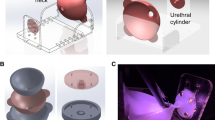Abstract
Background
The use of robotic systems for colorectal resections is well documented, but robotic surgery is not yet established as a substitute for all laparoscopic colorectal procedures. The features of the new-generation robotic system seem to be well suited for proper mesorectal excision, with the identification and preservation of autonomic pelvic nerves. Proper training in the use of robotic skills is essential.
Methods
This report describes the creation of a pelvic model that can be used to teach the complex skills needed for successful completion of robotic rectal dissection. The model was designed to be cost effective, portable, and reusable in multiple teaching programs. Both the setup and size of the trainer were designed to be the same as those for a real patient and to allow for proper simulation of port placement in a true robotic rectal dissection. The operative field was molded directly onto a replica of a human skeleton, and the materials that make up the trainer closely replicate the consistency of a real patient.
Results
To date, no adequate artificial pelvic models have been available for rectal dissection. Cadaveric models are expensive, and virtual reality trainers, although offering an attractive alternative for some procedures, currently are not available for complex robotic tasks such as rectal dissection. One major advantage of this trainer is that it allows for the surgeon to develop proficiency in both the areas of robotic setup and console without the assistance of a second surgeon.
Conclusions
The trainer described in this report provides an accurate simulation of true robotic rectal dissection. Its portability makes it easy to use at various hospitals. As robotic surgery becomes more common, this training tool has the potential to help surgeons quickly build the skills necessary for the successful use of robotic surgery in the area of rectal dissection.











Similar content being viewed by others
References
Giulianotti PC, Coratti A, Angelini M, Sbrana F, Cecconi F, Balestracci T, Caravaglios G (2003) Robotics in general surgery: personal experience in a large community hospital. Arch Surg 138:777–784
Delaney CP, Lynch AC, Senagore AJ, Fazio VW (2003) Comparison of robotically performed and traditional laparoscopic colorectal surgery. Dis Colon Rectum 46:1633–1639
D’Annibale A, Morpurgo E, Fiscon V, Trevisan P, Sovernigo G, Orsini C, Guidolin D (2004) Robotic and laparoscopic surgery for treatment of colorectal diseases. Dis Colon Rectum 47:2162–2168
Pigazzi A, Ellenhorn JD, Ballantyne GH, Paz IB (2006) Robotic-assisted laparoscopic low anterior resection with total mesorectal excision for rectal cancer. Surg Endosc 20:1521–1525
Rawlings AL, Woodland JH, Vegunta RK, Crawford DL (2007) Robotic versus laparoscopic colectomy. Surg Endosc March 13 Epub ahead of print
Marecik SJ, Chaudhry V, Jan A, Pearl RK, Park JJ, Prasad LM (2007) A comparison of robotic, laparoscopic, and hand–sewn intestinal sutured anastomoses performed by residents. Am J Surg Mar 193:349–355, discussion 355
Patel VR, Tully AS, Holmes R, Lindsay J (2005) Robotic radical prostatectomy in the community setting: the learning curve and beyond: initial 200 cases. J Urol 174:269–272
Munz Y, Kumar BD, Moorthy K, Bann S, Darzi A (2004) Laparoscopic virtual reality and box trainers: is one superior to the other? Surg Endosc 18:485–494
Halvorsen FH, Elle OJ, Dalinin VV, Mork BE, Sorhus V, Rotnes JS, Fosse E (2006) Virtual reality simulator training equals mechanical robotic training in improving robot-assisted basic suturing skills. Surg Endosc 20:1565–1569
Author information
Authors and Affiliations
Corresponding author
Additional information
Presented at the 2007 Sages Meeting, Las Vegas, NV, 22 April 2007
Rights and permissions
About this article
Cite this article
Marecik, S.J., Prasad, L.M., Park, J.J. et al. A lifelike patient simulator for teaching robotic colorectal surgery: how to acquire skills for robotic rectal dissection. Surg Endosc 22, 1876–1881 (2008). https://doi.org/10.1007/s00464-007-9736-4
Received:
Revised:
Accepted:
Published:
Issue Date:
DOI: https://doi.org/10.1007/s00464-007-9736-4




